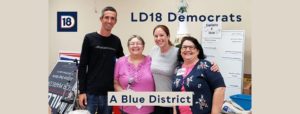
Planning for the next major elections in 2020 cannot wait until 2020. It actually started for most Legislative District (LD), County, State, and National Party Apparatuses in December 2018 and January 2019. At the LD level, organizational officers are either reelected or elected. Precinct Committeemen and Captains are asked to stay on while others are recruited. New candidates for local, state, and national offices are scouted and vetted. Voter Registration drives are organized, and fundraising never ceases.
The officeholders, staff, and volunteers who reside in Arizona Legislative District 18 (a district that includes parts of Ahwatukee-Phoenix, Tempe, Mesa, and Chandler) serve as a role model that many LDs will probably look to for guidance on how to assist their candidates as they campaign, hopefully, to victory in 2020. Once an all-red district in 2014, the LD is now all blue after the elections in 2018 of Sean Bowie in the State Senate and Mitzi Epstein and Jennifer Jermaine in the House.

Winning reelection as Legislative District 18 Democratic Chairperson, Dr. Janie Hydrick said in a question-and-answer session with Blog for Arizona that “unity is key” and it was essential to recruit “volunteer and PC talent and give them the room to do what they wanted to do” in order to get the desired electoral results.
The responses to the other questions from Blog for Arizona are below:
- In terms of moving forward, what are two things you would do the same in preparing for the 2020 election cycle?
“We would keep our neighborhood team leadership structure with 41 precincts in four cities divided into 14 neighborhood teams. We have a devoted leadership team that finds the time to devote to their precincts. Everyone works in tandem within and between those 14 teams. We do share with other (interested) LDs that can customize (to their region and demographics.) Starting early is the second one. We were not solely dependent on GOTV for success in 2018. In fact, GOTV was icing on the cake because for the many months before GOTV, we were already canvassing, promoting values, district, and infrastructure with the neighborhood team structure we had in place from the 2016 election. 92% of our candidates in four cities and statewide won. We’ll do even better in 2020.”
- In terms of moving forward, what are two things you would do differently in preparing for the 2020 election cycle?
“We did not have a deep bench of candidates. By January 2020, we want candidates that we have vetted for a wide range of positions including school boards and water boards. We also want to be able to collaborate sooner on campaigns with the Arizona Democratic Legislative Campaign Council (They were fantastic.)”
- Will you expect the same candidates that ran in 2018 to run again?
“Yes, and one of the things we are doing now is holding elected officials accountable. We have already started recruiting and vetting for 2020 because other elected positions will be open.”
- Please explain:
- 1) Method for recruiting P.C.’s
“We have 255 PCs, more than in any other LD in Arizona. We find out what people can do in terms of tasks, skills, and time, and then persuade them to do it. Red for Ed helped with recruitment by helping inspire teachers to become more involved politically, and a positive result of that was by recruiting active teachers to become PCs, gathering petition signatures and educating the electorate about positive public education policy.”
2) Method for recruiting candidates if the same ones do not run again.
“ We scout the people who regularly attend school board meetings and other political venues as well as those who attend our own LD18 events and club meetings.”
3) Fundraising and Marketing:
“ People who came on board as recurring donors for whatever amount are our mainstay. We constantly try to build that donor base. We also note people who attend our fundraising events and target them for attending more fundraising events and for becoming participants in non-fundraising LD18 events. LD18 puts the fun in fundraising.”
4) Voter Registration:
“By supporting the incredibly important and successful work of March for Our Lives, we have voter registration in all the high schools and apartment complexes. The ASU YDs have also been great partners.” Blog for Arizona contributor David Boyles is in charge of setting up a wide range of venues and events for registering new voters.
Dr. Hydrick and her team of talented volunteers have charted a path, as an earlier post-election piece relayed, to electoral victory that other LDs may borrow ideas from and “customize” to suit their regional needs. With Republicans not heeding the results of the 2018 elections by continuing to pursue their reactionary policies such as reducing the minimum wage for students under 21, expanding vouchers (despite what happened to Proposition 305 in November, 2018), regulating what teachers can say in the classroom, and increasing voter suppression, the need for Democrats to continue the momentum from 2018 is more apparent. Democratic activists and officeholders, as Dr. Hydrick said: “cannot be complacent.”
Discover more from Blog for Arizona
Subscribe to get the latest posts sent to your email.
